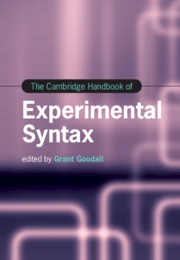Book contents
- The Cambridge Handbook of Experimental Syntax
- The Cambridge Handbook of Experimental Syntax
- Copyright page
- Contents
- Figures
- Tables
- Contributors
- Introduction
- Part I General Issues in Acceptability Experiments
- Part II Experimental Studies of Specific Phenomena
- Part III Experimental Studies of Specific Populations and Language Families
- 14 Acceptability Studies in L2 Populations
- 15 Judgments of Acceptability, Truth, and Felicity in Child Language
- 16 Acceptability and Truth-Value Judgment Studies in East Asian Languages
- 17 Acceptability Experiments in Romance Languages
- 18 Acceptability Studies in (Non-English) Germanic Languages
- 19 Acceptability Studies in Semitic Languages
- 20 Experimental Syntax and Slavic Languages
- 21 Acceptability Judgments in Sign Linguistics
- Part IV Experimental Syntax beyond Acceptability
- Index
- References
21 - Acceptability Judgments in Sign Linguistics
from Part III - Experimental Studies of Specific Populations and Language Families
Published online by Cambridge University Press: 16 December 2021
- The Cambridge Handbook of Experimental Syntax
- The Cambridge Handbook of Experimental Syntax
- Copyright page
- Contents
- Figures
- Tables
- Contributors
- Introduction
- Part I General Issues in Acceptability Experiments
- Part II Experimental Studies of Specific Phenomena
- Part III Experimental Studies of Specific Populations and Language Families
- 14 Acceptability Studies in L2 Populations
- 15 Judgments of Acceptability, Truth, and Felicity in Child Language
- 16 Acceptability and Truth-Value Judgment Studies in East Asian Languages
- 17 Acceptability Experiments in Romance Languages
- 18 Acceptability Studies in (Non-English) Germanic Languages
- 19 Acceptability Studies in Semitic Languages
- 20 Experimental Syntax and Slavic Languages
- 21 Acceptability Judgments in Sign Linguistics
- Part IV Experimental Syntax beyond Acceptability
- Index
- References
Summary
Much of the current research on grammar of sign languages involves using acceptability judgments by native signers. In contrast to spoken languages, very little research has been done to investigate the validity and reliability of this method. In this chapter, I discuss the current practice of using acceptability judgments in sign linguistics. I further discuss some cases of empirical disagreement among researchers working on the same phenomena demonstrating the need for more thorough methodological research. I also argue that the fact that sign languages exist in the visual modality, and some unusual sociolinguistic features of sign languages, can also influence the use of acceptability judgments, which should be investigated further. I conclude with some practical recommendations for collecting acceptability judgments from native signers, and include an example of a hypothetical study designed according to these recommendations.
Keywords
Information
- Type
- Chapter
- Information
- The Cambridge Handbook of Experimental Syntax , pp. 561 - 584Publisher: Cambridge University PressPrint publication year: 2021
References
Accessibility standard: Unknown
Why this information is here
This section outlines the accessibility features of this content - including support for screen readers, full keyboard navigation and high-contrast display options. This may not be relevant for you.Accessibility Information
- 2
- Cited by
